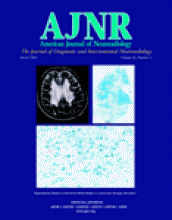Abstract
BACKGROUND AND PURPOSE: Contrast-enhanced fluid-attenuated inversion recovery (FLAIR) imaging has been reported to have higher sensitivity for detecting leptomeningeal disease compared with contrast-enhanced T1-weighted MR imaging. The purpose of this study was to compare contrast-enhanced T1-weighted MR images with fat suppression to contrast-enhanced FLAIR images to determine which sequence was superior for depicting meningeal disease.
METHODS: We reviewed MR images of 24 patients (35 studies) with a variety of meningeal diseases. The MR imaging protocol included contrast-enhanced T1-weighted MR images with fat suppression (FS) and contrast-enhanced fluid-attenuated inversion recovery (FLAIR) images that were reviewed by three neuroradiologists and were assigned a rating of positive, equivocal, or negative for abnormal meningeal enhancement. The two sequences were compared side by side to determine which better depicted meningeal disease.
RESULTS: Abnormal meningeal enhancement was positive in 35 contrast-enhanced T1-weighted MR images with FS and in 33 contrast-enhanced FLAIR studies. In the first group, which had the T1-weighted sequence acquired first (21 of 33 studies), contrast-enhanced T1-weighted images with FS showed superior contrast enhancement in 11 studies (52%), inferior contrast enhancement in six studies (29%), and equal contrast enhancement in four studies (19%) compared with the contrast-enhanced FLAIR images. In the second group, which had the FLAIR sequence acquired first (12 of 33), contrast-enhanced T1-weighted images with FS showed superior contrast enhancement in seven studies (58%), inferior contrast enhancement in two studies (17%), and equal contrast enhancement in three studies (25%).
CONCLUSION: Contrast-enhanced T1-weighted MR imaging with FS is superior to contrast-enhanced FLAIR imaging in most cases for depicting intracranial meningeal diseases.
- Copyright © American Society of Neuroradiology












